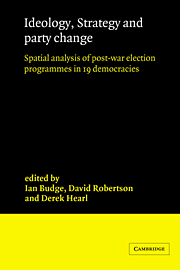 Ideology, Strategy and Party Change
Ideology, Strategy and Party Change Published online by Cambridge University Press: 27 October 2009
GOVERNMENT AND THE PARTY SYSTEM
The same struggle for independence which produced the party system of the Irish Republic also produced the Northern Irish State. In a situation of diminishing British control the Government of Northern Ireland was constituted in 1921 for the counties of Antrim, Armagh, Down, Fermanagh, Londonderry and Tyrone, with its administrative centre in Belfast. The rest of Ireland became a self-governing dominion. Thereafter the two parts of Ireland moved apart, although the nationalists both within and outside the North continued to demand unification of the island. In 1937 the new (Southern) Irish Constitution applied in theory everywhere. In 1949 the Irish Free State formally became the Republic of Ireland, following the passing of the Republic of Ireland Act (1948). In response, the Westminster Parliament in the Ireland Act (1949) gave a specific guarantee that Northern Ireland would remain part of the United Kingdom with legislative devolution over matters not of concern to the U.K. as a whole.
The Parliament was not sovereign. However, its institutions were modelled on those of Westminster. The legislature comprised the Crown, represented by a Governor, a House of Commons and a Senate. From 1929 elections were held on a simple plurality system in single member districts. The Senate consisted of 26 members and all but two ex-officio members were elected, by proportional representation, by the Lower House.
To save this book to your Kindle, first ensure no-reply@cambridge.org is added to your Approved Personal Document E-mail List under your Personal Document Settings on the Manage Your Content and Devices page of your Amazon account. Then enter the ‘name’ part of your Kindle email address below. Find out more about saving to your Kindle.
Note you can select to save to either the @free.kindle.com or @kindle.com variations. ‘@free.kindle.com’ emails are free but can only be saved to your device when it is connected to wi-fi. ‘@kindle.com’ emails can be delivered even when you are not connected to wi-fi, but note that service fees apply.
Find out more about the Kindle Personal Document Service.
To save content items to your account, please confirm that you agree to abide by our usage policies. If this is the first time you use this feature, you will be asked to authorise Cambridge Core to connect with your account. Find out more about saving content to Dropbox.
To save content items to your account, please confirm that you agree to abide by our usage policies. If this is the first time you use this feature, you will be asked to authorise Cambridge Core to connect with your account. Find out more about saving content to Google Drive.